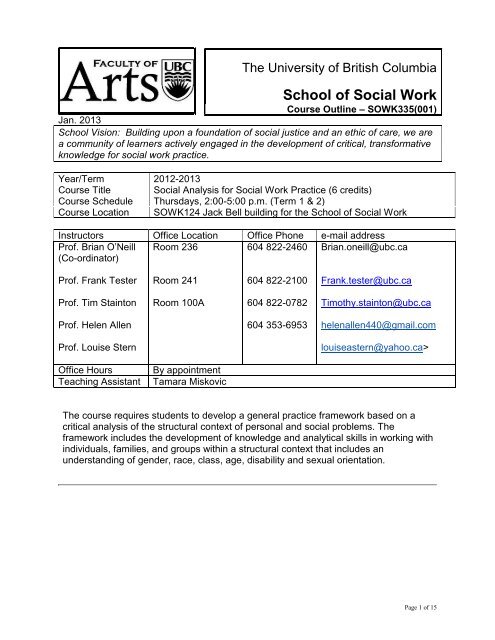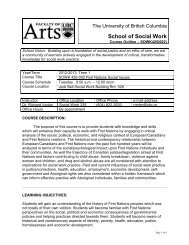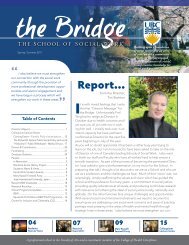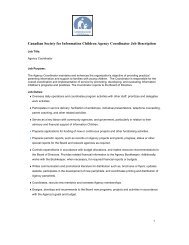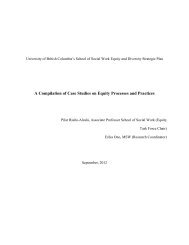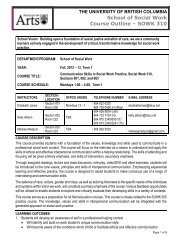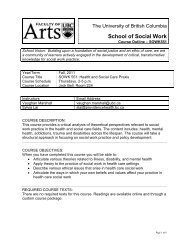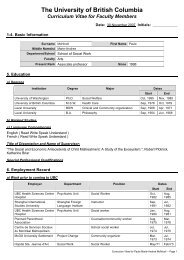SOWK 335.001. Social Analysis for Social Work Practice. - School of ...
SOWK 335.001. Social Analysis for Social Work Practice. - School of ...
SOWK 335.001. Social Analysis for Social Work Practice. - School of ...
Create successful ePaper yourself
Turn your PDF publications into a flip-book with our unique Google optimized e-Paper software.
The University <strong>of</strong> British Columbia<br />
<strong>School</strong> <strong>of</strong> <strong>Social</strong> <strong>Work</strong><br />
Course Outline – <strong>SOWK</strong>335(001)<br />
Jan. 2013<br />
<strong>School</strong> Vision: Building upon a foundation <strong>of</strong> social justice and an ethic <strong>of</strong> care, we are<br />
a community <strong>of</strong> learners actively engaged in the development <strong>of</strong> critical, trans<strong>for</strong>mative<br />
knowledge <strong>for</strong> social work practice.<br />
Year/Term 2012-2013<br />
Course Title <strong>Social</strong> <strong>Analysis</strong> <strong>for</strong> <strong>Social</strong> <strong>Work</strong> <strong>Practice</strong> (6 credits)<br />
Course Schedule Thursdays, 2:00-5:00 p.m. (Term 1 & 2)<br />
Course Location <strong>SOWK</strong>124 Jack Bell building <strong>for</strong> the <strong>School</strong> <strong>of</strong> <strong>Social</strong> <strong>Work</strong><br />
Instructors Office Location Office Phone e-mail address<br />
Pr<strong>of</strong>. Brian O’Neill Room 236<br />
604 822-2460 Brian.oneill@ubc.ca<br />
(Co-ordinator)<br />
Pr<strong>of</strong>. Frank Tester<br />
Room 241<br />
604 822-2100<br />
Frank.tester@ubc.ca<br />
Pr<strong>of</strong>. Tim Stainton<br />
Room 100A<br />
604 822-0782<br />
Timothy.stainton@ubc.ca<br />
Pr<strong>of</strong>. Helen Allen<br />
604 353-6953<br />
helenallen440@gmail.com<br />
Pr<strong>of</strong>. Louise Stern<br />
louiseastern@yahoo.ca><br />
Office Hours<br />
Teaching Assistant<br />
By appointment<br />
Tamara Miskovic<br />
The course requires students to develop a general practice framework based on a<br />
critical analysis <strong>of</strong> the structural context <strong>of</strong> personal and social problems. The<br />
framework includes the development <strong>of</strong> knowledge and analytical skills in working with<br />
individuals, families, and groups within a structural context that includes an<br />
understanding <strong>of</strong> gender, race, class, age, disability and sexual orientation.<br />
Page 1 <strong>of</strong> 15
<strong>SOWK</strong>335(001) – 2012-2013<br />
COURSE OBJECTIVES:<br />
1. To examine theoretical and practice contributions to structural approaches within<br />
an historical context.<br />
2. To develop a critical understanding <strong>of</strong> the relationship between the organization<br />
<strong>of</strong> social work practice and gender, race, class, age disability and sexual<br />
orientation.<br />
3. To examine the function <strong>of</strong> ideology in shaping ways that individual and social<br />
problems are constructed, perceived, defined and addressed through practice<br />
responses.<br />
4. To examine ways <strong>of</strong> redefining/renaming " social problems " from a structural<br />
perspective and making them central to our work as well as to critically examine<br />
one's own personal value orientations and practices that are linked to the<br />
maintenance and perpetuation <strong>of</strong> oppression.<br />
5. To develop a structural theoretical framework <strong>for</strong> social analysis and social work<br />
intervention with individuals, families and groups.<br />
6. To develop a critical awareness <strong>of</strong> worker social location, pr<strong>of</strong>essional ethics,<br />
and power within the helping relationship and to identify attitudes, behaviours<br />
and practices that contribute to anti-oppressive practice and empowerment<br />
strategies in social work practice<br />
COURSE PROCESS AND EXPECTATIONS FOR ALL CLASS MEMBERS<br />
Class members are expected to attend regularly and to come prepared to participate. In<br />
particular, students should complete required readings prior to class. There is an<br />
expectation that differing opinions, analysis and experiences will be discussed in a<br />
respectful manner and that such an exchange contributes to the learning <strong>of</strong> all.<br />
REQUIRED READINGS:<br />
Thompson, N. (2012). Anti-discriminatory practice: Equality, diversity and social justice<br />
(5 th ed.). New York, NY: Palgrave Macmillan.<br />
Seabrook, J. (2002). The no-nonsense guide to class, caste and hierarchy. Toronto:<br />
Between the Lines Press.<br />
Other readings in ejournals or Vista.<br />
Page 2 <strong>of</strong> 15
<strong>SOWK</strong>335(001) – 2012-2013<br />
COURSE ASSIGNMENTS, DUE DATES AND GRADING<br />
Reflective Papers - submit paper copies to Teaching Assistant<br />
Value: 10% each x 5 <strong>for</strong> a total <strong>of</strong> 50% - see evaluation guidelines at end <strong>of</strong> outline<br />
Length: approximately 4 pages double-spaced<br />
Due:<br />
Class module: Nov 1, 2012<br />
Disability module: Nov 29<br />
Feminisms module: Jan 31, 2013<br />
Gender identity and sexual orientation module: March 7, 2013<br />
Ageism module: April 11, 2013<br />
Assignments should con<strong>for</strong>m to style <strong>of</strong> the Publication Manual <strong>of</strong> the American<br />
Psychological Association (6 th ed.).<br />
Exam in December exam period (20%) and Spring exam period 30% <strong>for</strong> a total <strong>of</strong><br />
50%. Each exam deals with the class material in that term and is not cumulative.<br />
COURSE POLICIES [attendance, participation, academic dishonesty]:<br />
Excerpt from the UBC calendar:<br />
Regular attendance is expected <strong>of</strong> students in all their classes (including lectures, laboratories, tutorials, seminars,<br />
etc.). Students who neglect their academic work and assignments may be excluded from the final examinations.<br />
Students who are unavoidably absent because <strong>of</strong> illness or disability should report to their instructors on return to<br />
classes.<br />
The University accommodates students with disabilities who have registered with the Disability Resource Centre.<br />
The University accommodates students whose religious obligations conflict with attendance, submitting<br />
assignments, or completing scheduled tests and examinations. Please let your instructor know in advance,<br />
preferably in the first week <strong>of</strong> class, if you will require any accommodation on these grounds. Students who plan to<br />
be absent <strong>for</strong> varsity athletics, family obligations, or other similar commitments, cannot assume they will be<br />
accommodated, and should discuss their commitments with the instructor be<strong>for</strong>e the drop date.<br />
It is recommended that students retain a copy <strong>of</strong> all submitted assignments (in case <strong>of</strong> loss) and should also retain<br />
all their marked assignments in case they wish to apply <strong>for</strong> a Review <strong>of</strong> Assigned Standing. Students have the right<br />
to view their marked examinations with their instructor, providing they apply to do so within a month <strong>of</strong> receiving their<br />
final grades. This review is <strong>for</strong> pedagogic purposes. The examination remains the property <strong>of</strong> the university.<br />
Academic Dishonesty:<br />
Please review the UBC Calendar “Academic regulations” <strong>for</strong> the university policy on cheating, plagiarism, and other<br />
<strong>for</strong>ms <strong>of</strong> academic dishonesty. Also visit www.arts.ubc.ca and go to the students’ section <strong>for</strong> useful in<strong>for</strong>mation on<br />
avoiding plagiarism and on correct documentation.<br />
• Students who miss more than 3 classes may be refused the right to hand in a final<br />
assignment. Attendance sheets must be signed during each class.<br />
• Participation is expected <strong>of</strong> all students beyond simple attendance. Students are<br />
expected to read all <strong>of</strong> the assigned readings be<strong>for</strong>e every class and to come to<br />
class prepared to discuss the material.<br />
Page 3 <strong>of</strong> 15
<strong>SOWK</strong>335(001) – 2012-2013<br />
• Students who use electronic devices to aid in their learning process (e.g. laptop<br />
computers) must have the permission <strong>of</strong> the instructor to use the device and, if<br />
permission is granted, must have the wireless capacity <strong>of</strong> the device turned <strong>of</strong>f.<br />
• All cell phones must be turned <strong>of</strong>f.<br />
COURSE SCHEDULE, Term 1<br />
Week 1: Sept 6, Introduction Pr<strong>of</strong>essor Brian O’Neill<br />
Thompson (2012): Introduction<br />
Ch. 1: Equality,diversity and social justice<br />
Week 2: Sept 13, Theoretical frameworks<br />
Thompson (2012): Ch. 2: The theory base<br />
Ch. 4: Ethnicity and racism<br />
Week 3: Sept 20, Debates<br />
Campbell, C. (2003). Anti-oppressive theory and practice as the organizing theme <strong>for</strong><br />
social work education: The case in favour. Canadian <strong>Social</strong> <strong>Work</strong> Review, 20(1), 121-<br />
125.<br />
Tester, F. J. (2003). Anti-oppressive theory and practice as the organizing theme <strong>for</strong><br />
social work education: The case against. Canadian <strong>Social</strong> <strong>Work</strong> Review, 20(1), 127-<br />
132.<br />
Campbell, C. (2003). Rebuttal: <strong>Work</strong>ing within contradiction and ambiguity. Canadian<br />
<strong>Social</strong> <strong>Work</strong> Review, 20(1), 133-135.<br />
Tester, F. J. (2003). Rebuttal: Difference, dissent, and common ground. Canadian<br />
<strong>Social</strong> <strong>Work</strong> Review, 20(1), 137-138.<br />
Prior, J. (2004). Anti-oppressive practice: Why bother?In H. G. Eriksson & T. Tjelflaat<br />
(Eds.), Residential care: Horizons <strong>for</strong> the new century (pp. 3-22). Aldershot, Hants,<br />
England: Ashgate Publishing.<br />
Week 4: Sept 27, Reflexive <strong>Practice</strong><br />
D’Cruz, H., Gillingham, P. and Melendez, S. (2007) ‘Reflexivity, its meanings and<br />
relevance <strong>for</strong> social work: A critical review <strong>of</strong> the literature’, British Journal <strong>of</strong><br />
<strong>Social</strong> <strong>Work</strong>, 37(1), pp. 73–90.<br />
Butler, A., Ford, D. and Tregaskis, C. 2007. Who Do We Think We Are? Self and<br />
Reflexivity in <strong>Social</strong> <strong>Work</strong> <strong>Practice</strong>. Qualitative <strong>Social</strong> <strong>Work</strong>; 6; 281<br />
Page 4 <strong>of</strong> 15
<strong>SOWK</strong>335(001) – 2012-2013<br />
Weeks 5-8: <strong>Social</strong> Class – Pr<strong>of</strong>essor Frank Tester<br />
Week 5: Oct 4<br />
Wherein we discover the historical importance <strong>of</strong> the now seldom-appreciated concept <strong>of</strong><br />
‘social class’ and come to grips with how classes were created. We discover to our<br />
amazement, the ongoing relevance <strong>of</strong> the concept to a ‘globalized’ world. We journey to<br />
London England, not merely to partake <strong>of</strong> trendy musicals and to consume some ‘high’<br />
fashion, but to visit High Park Cemetery, there to pay our respects to Karl Marx, without<br />
whose phenomenal insights, the machinations <strong>of</strong> contemporary capitalist relations <strong>of</strong><br />
production might remain a pale mystery.<br />
Readings: ‘Class, Caste & Hierarchies’, Chapters 1 & 2.<br />
Week 6: Oct 11<br />
Where we find ourselves thoroughly ‘jarred’ by the introduction to western cultures <strong>of</strong> ‘<br />
identity politics’ - a focus on race, gender, sexual orientation and ethnicity - submerged in<br />
discourse around the achievement <strong>of</strong> ‘equality’ (defined primarily in non-material ways). We<br />
wrestle with the possibility <strong>of</strong> this as a convenient diversion, side-tracking us from the<br />
development <strong>of</strong> any real threat to the most oppressive relations <strong>of</strong> our time – those that<br />
give rise to other inequalities. We discover cultural theory (barely). Charlie Chaplin (once<br />
banned from the United States <strong>for</strong> his Communist sympathies) –with wit and humour -<br />
introduces us to the bread and roses <strong>of</strong> ‘Modern Times’.<br />
Readings: ‘Class, Caste & Hierarchies’, Chapters 3 & 4.<br />
Week 7: Oct 18<br />
Whereupon we crawl tentatively onto the international stage. Look out Naomi Klein.<br />
Here we come! We confront the real possibility that there is more slave labour in the<br />
world in 2012 than there was at the time slavery was <strong>of</strong>ficially abolished in the 1800s.<br />
Farewell to the working class – are you kidding! But what, we ask, does this have to do<br />
with social work? Am I in the right programme? I just want a com<strong>for</strong>table job with good<br />
pay! Go away! Stop bothering me! Things are fine the way they are. All that is needed is<br />
a bit <strong>of</strong> tinkering here and there. Body sculptures showing class relations (no, I don’t<br />
mean how well you are getting along with each other)? Now that’s different!<br />
Readings: ‘Class, Caste & Hierarchies’, Chapters 5, 6, 7 & 8.<br />
Week 8: Oct. 25<br />
We savor a potpourri <strong>of</strong> possibilities. There are actually people here in Vancouver trying to<br />
do something about this stuff. We may receive visitors; some <strong>of</strong> whom have never taken a<br />
social work course in their lives and are nevertheless at the <strong>for</strong>efront <strong>of</strong> working <strong>for</strong> social<br />
change. Good grief! We ‘check our heads’. We discover (hopefully) that they are still intact,<br />
but perhaps disturbed.<br />
Page 5 <strong>of</strong> 15
<strong>SOWK</strong>335(001) – 2012-2013<br />
On the other hand, we may be subjected to a film. Anyone heard <strong>of</strong> a guy named Michel<br />
Moore?<br />
Readings: none! (How about that!) – But wait a minute. Each student brings to class the<br />
title <strong>of</strong> a book, film or paper that extends or deals in some way with the subjects <strong>of</strong> this<br />
module and that s/he has been inspired to look at as a result <strong>of</strong> this section <strong>of</strong> 335. We<br />
create a giant reading list. Some students quit the programme and complete their<br />
education by reading everything on the list. The pr<strong>of</strong>essor is fired and spends the rest <strong>of</strong><br />
his career (like many academics) reading about social change.<br />
[Frank will be away in Washington this week and the class will be managed by one <strong>of</strong><br />
his doctoral students.]<br />
Weeks 9-12: Disability – Pr<strong>of</strong>essor Tim Stainton<br />
Week 9: Nov 1: DISABILITY AND THE POLITICS OF<br />
DEFINITION/DEMOGRAPHICS<br />
FROM READER:<br />
Finkelstein, Vic "Revolution", New Internationalist, No. 233, July, 1992<br />
July 1992.<br />
Rothman, Juliet (2003). <strong>Social</strong> <strong>Work</strong> <strong>Practice</strong> Across Disability. Boston: Allyn and Bacon.<br />
Chp 1. Theoretical Frameworks.<br />
FROM: WEB:<br />
Government <strong>of</strong> Canada (2009) Advancing the Inclusion <strong>of</strong> People with Disabilities<br />
http://www.hrsdc.gc.ca/eng/disability_issues/reports/fdr/2009/page00.shtml<br />
Week 10: Nov 8: ACCESS AND LIVING WITH A DISABILITY<br />
Gill, Carol (2001) “The <strong>Social</strong> Experience <strong>of</strong> Disability’ in Albrecht, Gary, Seelman,<br />
Katherine & Bury, M. eds. (2001) Handbook <strong>of</strong> Disability Studies. Thousand Oaks CA:<br />
Sage. Chp. 13, p.p. 351-372.<br />
McDonnell, John J. et al (2003). An introduction to persons with severe disabilities:<br />
educational and social issues. 2nd edition. Boston : Allyn and Bacon. Chp. 6 Assistive<br />
Devices.<br />
From the web re: Universal design<br />
http://www.design.ncsu.edu/cud/about_ud/udprincipleshtml<strong>for</strong>mat.html#top<br />
Page 6 <strong>of</strong> 15
<strong>SOWK</strong>335(001) – 2012-2013<br />
Week 11: Nov 15: <strong>Social</strong> <strong>Work</strong> <strong>Practice</strong> and Disability<br />
Dunn, Peter (2003) Canadians with Disabilities. In Anne Westhues, ed. Canadian<br />
<strong>Social</strong> policy: Issues and Perspectives. Waterloo: Wilfrid Laurier University<br />
Press.<br />
Stainton, Tim (2005 ) Empowerment and the architecture <strong>of</strong> rights based social policy.<br />
British Journal <strong>of</strong> Learning Disabilities.<br />
Thompson (2012). Ch. 6: Disability and social handicap<br />
Week 12: Nov 22: OPPRESSION AND ETHICS<br />
Asch, A. and Parens E. (2000) ‘The Disability Rights Critique <strong>of</strong> Prenatal Genetic<br />
testing: Reflections and Recommendations’ in Asch, A. and Parens E. (eds.)<br />
Prenatal Testing and Disability Rights. Washington: Georgetown Univ. Press.<br />
p.p. 3-43.<br />
Stainton, Tim (1998)“Intellectual Disability, Difference, and Oppression” in Bogdan<br />
Lesnik ed. Countering Discrimination in <strong>Social</strong> <strong>Work</strong>. Aldershot: Ashgate/Arena.<br />
Week 13: Nov 29: Review - Brian O’Neill<br />
Page 7 <strong>of</strong> 15
<strong>SOWK</strong>335(001) – 2012-2013<br />
Course Schedule, term 2<br />
Weeks 1-4: Feminisms – Pr<strong>of</strong>essor Helen Allen<br />
Week 1: Jan 3, Who’s Counting? Sex, Lies and Global Economics.<br />
Marilyn Waring video.<br />
Judith Lorber pps 1-21. Gender Inequality: Feminist Theories and Politics.<br />
http://www.socqrl.niu.edu/myers/feminisms.html<br />
Week 2: Jan 10, Gender Re<strong>for</strong>m Feminisms:<br />
http://roxbury.net/images/pdfs/gi3ch1.pdf<br />
Brown, Leslie, Callahan, Marilyn, Strega, Susan, Walmsley, Christopher and Dominelli,<br />
Lena. 2009. Manufacturing ghost fathers: the paradox <strong>of</strong> father presence and absence<br />
in child welfare. Child and Family <strong>Social</strong> <strong>Work</strong>, 14, pp 25–34.<br />
Christine L. Williams. 1992. The Glass Escalator: Hidden Advantages <strong>for</strong> Men in the<br />
“Female” Pr<strong>of</strong>essions. <strong>Social</strong> Problems. 39. 253-267.<br />
Week 3: Jan 17, Gender Resistance Feminisms<br />
Thompson, Chapter 3: Gender and sexism<br />
Shantih E. Clemans 2004 Life Changing: The Experience <strong>of</strong> Rape-Crisis <strong>Work</strong> Affilia<br />
19; 146.<br />
Grant, Judith. 2006. Andrea Dworkin and the <strong>Social</strong> Construction <strong>of</strong> Gender: A<br />
Retrospective. Signs: Journal <strong>of</strong> Women in Culture and Society. Volume 31, Issue 4,<br />
Page 967–993, Jun 2006.<br />
Week 4: Jan 24, Gender Rebellion Feminisms<br />
Lotz, D. 2003. Communicating Third Wave Feminism and New <strong>Social</strong> Movements:<br />
Challenges <strong>for</strong> the Next Century <strong>of</strong> Feminist Endeavor. Women and Language. 26, 1,<br />
2-9.<br />
Neysmith Sheila M., Reitsma-Street, Marge. 2005. Provisioning: Conceptualizing the<br />
work <strong>of</strong> women <strong>for</strong> 21st century social policy. Women’s Studies International Forum<br />
28,381– 391.<br />
Page 8 <strong>of</strong> 15
<strong>SOWK</strong>335(001) – 2012-2013<br />
Weeks 5-9: Gender Identity and Sexual Diversity – Pr<strong>of</strong>essor Brian O’Neill<br />
Week 5: Jan 31, 2013, Diversity in sexual orientation and gender: Definitions &<br />
theories<br />
Required readings:<br />
Todd, S. (2010). Chapter 14: <strong>Social</strong> work and sexual and gender diversity: Celebrating<br />
human diversity. In S. F. Hick (Ed.), <strong>Social</strong> work in Canada: An introduction (3rd ed.).<br />
Toronto, ON: Thompson Educational Publishing.<br />
Cameron, M. (2005). Two-spirited Aboriginal people: Continuing cultural appropriation<br />
by non-aboriginal society. Canadian Woman Studies, 24(2/3), 123-127.<br />
Nagoshi, J. L., & Brzuzy, S. (2010). Transgender theory: Embodying research and<br />
practice. Affilia, 25(4), 431-443. doi: 10.1177/0886109910384068<br />
Oswalt, S. B. (2009). Don’t <strong>for</strong>get the “B”: Considering bisexual students and their<br />
specific health needs. Journal <strong>of</strong> American College Health, 57(5), 557-561.<br />
doi:10.3200/JACH.57.5.557-560<br />
Supplementary Readings<br />
Bailey, J. M. (2009). What is sexual orientation and do women have one? In D. A. Hope<br />
(Ed.), Contemporary perspectives on lesbian, gay and bisexual identities (pp. 43-<br />
63). New York, NY: Springer. doi:10.1007/978-0-387-09556-1_3<br />
Diamond, L. M. (2003). What does sexual orientation orient? A biobehavioral model<br />
distinguishing romantic love and sexual desire. Psychological Review, 110(1),<br />
173-192. doi:10.1037/0033-295X.110.1.173<br />
Fredriksen-Goldsen, K. I., Kim, H. J., & Barkan, S. E. (2012). Disability among lesbian,<br />
gay, and bisexual adults: Disparities in prevalence and risk. American Journal <strong>of</strong><br />
Public Health, 102( 1), e16-e21. doi: 10.2105/AJPH.2011.300379<br />
Hatzenbuehler, M. L., O'Cleirigh, C., Grasso, C., Mayer, K., Safren, S., & Brad<strong>for</strong>d, J.<br />
(2011). Effect <strong>of</strong> same-sex marriage laws on health care use and expenditures in<br />
sexual minority men: A quasi-natural experiment. American Journal <strong>of</strong> Public<br />
Health. e-View Ahead <strong>of</strong> Print. doi: 10.2105/AJPH.2011.300382<br />
Kinsey, A.C., Pomeroy, W.B., & Martin, C.E. (1948). Sexual behavior in the human<br />
male. Philadelphia, PA: W.B. Sanders.<br />
Kinsey, A.C., Pomeroy, W.B., Martin, C.E., & Gebhard, P. (1955). Sexual behavior in<br />
the human female. Philadelphia, PA: W.B. Sanders<br />
Kurtzman, H. S., & Omoto, A. M. (2006). Introduction: Current and future research on<br />
lesbian, gay and bisexual people. In A. M. Omoto & H. S. Kurtzman (Eds.),<br />
Page 9 <strong>of</strong> 15
<strong>SOWK</strong>335(001) – 2012-2013<br />
Sexual orientation and mental health: Examining identity and development in<br />
lesbian, gay, and bisexual people. Washington, DC: American Psychological<br />
Association. [on-line]<br />
Rosario, M., Schrimshaw, E. E., & Hunter, J. (2011). Different patterns <strong>of</strong> sexual identity<br />
development over time: Implications <strong>for</strong> the psychological adjustment <strong>of</strong> lesbian,<br />
gay, and bisexual youths. Journal <strong>of</strong> Sex Research, 48(1), 3-15.<br />
doi:10.1080/00224490903331067<br />
Savin-Williams, R. C. (2009). How many gays are there? It depends. In D. A. Hope<br />
(Ed.), Contemporary perspectives on lesbian, gay and bisexual identities (pp. 5-<br />
41). New York, NY: Springer.<br />
Taylor, C., & Ristock, J. (2011). LGBTQ families in Canada: Private lives and public<br />
discourse. In N. Mandell & A. Duffy (Eds.), Canadian families: Diversity, conflict,<br />
and change (4th ed.) (pp. 125-163). Toronto, ON: Nelson Education.<br />
Week 6: February 7, 2013, <strong>Social</strong> justice issues in relation to SO & GI<br />
Required readings:<br />
Thompson, Chapter 7: Sexuality and heterosexism<br />
Walls, N. E. (2008). Toward a multidimensional understanding <strong>of</strong> heterosexism: The<br />
changing nature <strong>of</strong> prejudice. Journal <strong>of</strong> Homosexuality, 55(1), 20-70.<br />
Fish, J. (2010). Conceptualising social exclusion and lesbian, gay, bisexual, and<br />
transgender people: The implications <strong>for</strong> promoting equity in nursing policy and<br />
practice. Journal <strong>of</strong> Research in Nursing, 15(4), 303-312. doi:<br />
10.1177/1744987110364691<br />
Supplementary readings:<br />
Bruce-Jones, E., & Itaborahy, L. P. (2011). State-sponsored homophobia: A world<br />
survey <strong>of</strong> laws criminalizing same-sex sexual acts between consenting adults.<br />
International Lesbian, Gay, Bisexual, Trans and Intersex Association (ILGA).<br />
Retrieved from www.ilga.org<br />
Davis, K. (2008). Intersectionality as buzzword: A sociology <strong>of</strong> science perspective on<br />
what makes a feminist theory successful. Feminist Theory, 9(1), 67-85.<br />
doi:10.1177/1464700108086364<br />
Fish, J. (2008). Far from mundane: Theorising heterosexism <strong>for</strong> social work education.<br />
<strong>Social</strong> <strong>Work</strong> Education, 27(2), 182-193. doi:10.1080/02615470701709667<br />
Herek, G.M. (2009). Sexual stigma and sexual prejudice in the United States: A<br />
conceptual framework. In D. A. Hope (Ed.), Contemporary perspectives on<br />
lesbian, gay, and bisexual identities (pp. 65-111). New York, NY: Springer. [online]<br />
Page 10 <strong>of</strong> 15
<strong>SOWK</strong>335(001) – 2012-2013<br />
Neisen, J. H. (1990). Heterosexism: Redefining homophobia <strong>for</strong> the 1990s. Journal <strong>of</strong><br />
Gay and Lesbian Psychotherapy, 1(3), 21-35. Doi: 10.1300/J236v01n03_02<br />
Pharr, S. (1988). Homophobia: A weapon <strong>of</strong> sexism. Little Rock, AR: Chardon Press.<br />
Week 7: February 14, <strong>Practice</strong> at the personal level: Intake & engagement; data<br />
gathering & assessment; planning & contracting; intervention & monitoring;<br />
evaluation & termination<br />
Required readings:<br />
Crisp, C., & McCave, E. L. (2007). Gay affirmative practice: A model <strong>for</strong> social work<br />
practice with gay, lesbian, and bisexual youth. Child and Adolescent <strong>Social</strong> <strong>Work</strong><br />
Journal, 24(4), 403-421. doi: 10.1007/s10560-007-0091-z<br />
Hess, P. M., & Feldman, N. (2008). Values and ethics in social work practice with<br />
lesbian, gay, bisexual and transgender persons. In G. P. Mallon (Ed.), <strong>Social</strong> work<br />
practice with lesbian, gay. bisexual and transgender people (2 nd ed., pp. 25-38). New<br />
York, NY: Routledge. [on-line]<br />
Hunter, S. (2011). Micro-level issues and practice with lesbian and gay couples. In<br />
Lesbian and gay couples: Lives, issues, and practice.(pp. 77-96) Chicago, IL: Lyceum<br />
Books. [on-line at lyceumbooks.com]<br />
Lev, A. I. (2009). The ten tasks <strong>of</strong> the mental health provider: Recommendations <strong>for</strong><br />
revision <strong>of</strong> the World Pr<strong>of</strong>essional Association <strong>for</strong> Transgender Health’s Standards <strong>of</strong><br />
Care. International Journal <strong>of</strong> Transgenderism, 11, 74–99. DOI:<br />
10.1080/15532730903008032<br />
Supplementary reading:<br />
Shea<strong>for</strong>, B., Horeijsi, C. (2006). Techniques and guidelines in social work practice (7th<br />
ed.). New York: Pearson.<br />
Coates, J., & Sullivan, R. (2005). Achieving competent family practice with same-sex<br />
parents: Some promising directions. Journal <strong>of</strong> GLBT Family Studies, 1(2), 89-114.<br />
Freundlich, M., & Avery, R. J. (2004). Gay and lesbian youth in foster care: Meeting<br />
their placement and service needs. Journal <strong>of</strong> Gay and Lesbian <strong>Social</strong> Services, 17(4),<br />
39-57.<br />
Morrow, D. F., & Messinger, L. (Eds.) (2006). Sexual orientation and gender<br />
expression in social work practice: working with gay, lesbian, bisexual, and transgender<br />
people. New York, NY: Columbia University Press.<br />
Week 8: Feb 21 – Reading Week – no class<br />
Page 11 <strong>of</strong> 15
<strong>SOWK</strong>335(001) – 2012-2013<br />
Week 9: Feb 28, <strong>Practice</strong> at the structural and cultural levels<br />
Required Readings:<br />
Daley, A. (2006). Lesbian and gay health issues: OUTside <strong>of</strong> Canada’s health policy.<br />
Critical <strong>Social</strong> Policy, 26, 794-816. doi:10.1177/0261018306068474<br />
Ji, P., Du Bois, S. N., & Finnessy. P. (2009). An academic course that teaches<br />
heterosexual students to be allies to LGBT communities: A qualitative analysis.<br />
Journal <strong>of</strong> Gay & Lesbian <strong>Social</strong> Services, 21(4), 402-429.<br />
Lepischak, B. (2004). Building community <strong>for</strong> Toronto’s lesbian, gay, bisexual,<br />
transsexual and transgender youth. Journal <strong>of</strong> Gay and Lesbian <strong>Social</strong> Services,<br />
16(3/4), 81-98. (on-line)<br />
Mule, N. J. (2006). Equity vs. Invisibility: Sexual orientation issues in social work<br />
ethics and curricula standards. <strong>Social</strong> <strong>Work</strong> Education, 25(6), 608-622.<br />
Mule, N. (2010). Same-sex marriage and Canadian relationship recognition – One step<br />
<strong>for</strong>ward, two steps back: A critical liberationist perspective. Journal <strong>of</strong> Gay and<br />
Lesbian <strong>Social</strong> Services, 22, 74-90. doi:10.1080/10538720903332354<br />
Supplementary readings:<br />
Dobbie, D. & Richards-Schuster, K. (2008). Building solidarity through difference: A<br />
practice model <strong>for</strong> critical multicultural organizing. Journal <strong>of</strong> Community <strong>Practice</strong>,<br />
16(3), 317-337.<br />
Messinger, L. (2004). Out in the field: Gay and lesbian social work students’<br />
experiences in field placement. Journal <strong>of</strong> <strong>Social</strong> <strong>Work</strong> Education, 40(2), 187-204.<br />
(on-line)<br />
Meyer-Cook, F., & Labelle, D. (2004). Namaji: Two-Spirit organizing in Montreal,<br />
Canada. Journal <strong>of</strong> Gay & Lesbian <strong>Social</strong> Services, 16(1), 29-51.<br />
Weeks 10-13: Aging – Pr<strong>of</strong>essor Louise Stern<br />
The purpose <strong>of</strong> this module is to provide students with an introduction and overview <strong>of</strong><br />
social issues related to aging. An objective will be to develop a critical lens <strong>for</strong><br />
examining social work practice in the field <strong>of</strong> aging. The focus will be on critically and<br />
reflexively exploring societal attitudes about aging and older adults, the theories used to<br />
understand the aging experience , and how those may impact some <strong>of</strong> the issues that<br />
older adults face. Finally, how do social work practitioners respond to these issues and<br />
what are some <strong>of</strong> the structural and systemic challenges that they face in working with<br />
this population?<br />
The <strong>for</strong>mat <strong>of</strong> the class will consist <strong>of</strong> lectures, discussions, group exercises, and video<br />
presentations. Completing the readings as scheduled is expected as it will help to<br />
Page 12 <strong>of</strong> 15
<strong>SOWK</strong>335(001) – 2012-2013<br />
contribute to class discussions and with the student’s understandings <strong>of</strong> the topics at<br />
hand.<br />
Week 10: Mar 7, The <strong>Social</strong> Context <strong>of</strong> Aging<br />
Minichiello, V., Browne, J. And Kendig, H. (2000). Perceptions and consequences <strong>of</strong><br />
ageism: Views <strong>of</strong> older people. Ageing and Society, 20, 253-278.<br />
Gellis, Z.D., Sherman, S. and Lawrance, F. (2003) First year graduate social work<br />
students knowledge <strong>of</strong> and attitudes towards older adults. Educational Gerontology,<br />
29(1), 1-16.<br />
Week 11: Mar 14, Gerontological Theories <strong>of</strong> Aging and Their Impacts<br />
Biggs, S. Phillipson, C., Money, A-M., and Leach, R. (2006). The age-shift:<br />
Observations on the social policy, ageism and the dynamics <strong>of</strong> the adult life course.<br />
Journal <strong>of</strong> <strong>Social</strong> <strong>Work</strong> <strong>Practice</strong>, 20(3), 239-250.<br />
Liang, J., and Luo, B. (2012). Towards a successful shift in social gerontology: From<br />
successful aging to harmonious aging. Journal <strong>of</strong> Aging Studies, 26, 327-344.<br />
Week 12: Mar 21, <strong>Social</strong> <strong>Work</strong> <strong>Practice</strong> Issues with Older People<br />
Ray, M., Bernard, M., and Philips, J. (2009). Critical Issues in <strong>Social</strong> <strong>Work</strong> with<br />
Older People, Ch. 2, Developing Critical Gerontological <strong>Social</strong> <strong>Work</strong>, pp 35-52.<br />
O'Connor, D. (2003). Anti-oppressive practice with older adults: A feminist poststructuralist<br />
perspective. In W. Shearer (ed), Emerging Perspectives on Anti-<br />
Oppressive <strong>Practice</strong>. Toronto: Canadian Scholars Press.<br />
Week 13: Mar 28, <strong>Social</strong> <strong>Work</strong> Assessments and Interventions with Older People<br />
Greene, R.R., and Cohen, H.L. (2005). <strong>Social</strong> work and older adults and their<br />
families: Changing the practice paradigms. Families in Society, 86(3), 367-373.<br />
Week 14: Ap 4 Reflections – Pr<strong>of</strong>essor Brian O’Neill<br />
ASSIGNMENTS<br />
Page 13 <strong>of</strong> 15
<strong>SOWK</strong>335(001) – 2012-2013<br />
Submitting Assignments-<br />
Students can use the drop box located in the main <strong>of</strong>fice on the reception counter to<br />
submit their assignments or any correspondence to faculty, sessionals or staff. Items<br />
will be date-stamped and distributed to the appropriate mailbox throughout the day.<br />
Return <strong>of</strong> marked student assignments -<br />
Instructors coordinate the return <strong>of</strong> marked assignments. The options are as follows:<br />
a) the instructor returns the paper to students in class; b) if the paper has been<br />
submitted electronically, the instructor will mark it on-line (with track changes) and<br />
return to the student on-line; c) the instructor returns the paper to the student by snail<br />
mail (the student provides a self-stamped, addressed envelope to the instructor).<br />
Marked papers not returned by any <strong>of</strong> the options above will be held by the instructor.<br />
Marked papers will no longer be put in a box outside the instructor’s <strong>of</strong>fice or at the<br />
main <strong>of</strong>fice counter.<br />
Late assignments-<br />
Extensions are granted only in cases <strong>of</strong> personal illness or family issues and not<br />
because <strong>of</strong> academic workload or conflicts. Extensions must be requested in advance<br />
<strong>of</strong> the due date <strong>of</strong> the assignment. Grades may be reduced by one point <strong>for</strong> each day<br />
(including weekends) late unless an emergency outside the control <strong>of</strong> the student<br />
prevents meeting deadline. Assignments must be handed at the beginning <strong>of</strong> class on<br />
the due date.<br />
Student:<br />
<strong>Social</strong> <strong>Work</strong> 335/505<br />
Marks <strong>for</strong> Reflective Paper<br />
Organization <strong>of</strong> the paper: /25%<br />
<strong>Analysis</strong>: descriptions <strong>of</strong> what important/striking/significant to you in module &<br />
discussion <strong>of</strong> meaning to you – intellectual, emotional, practical …<br />
/25%<br />
Implications <strong>for</strong> your social work practice: /25%<br />
Quality <strong>of</strong> the writing: /25%<br />
Total:<br />
Note: The emphasis should be on your own thoughts, feelings, experiences …<br />
However, if you do cite works in your reflections, use APA 5 th ed style in the<br />
reference list<br />
Page 14 <strong>of</strong> 15
<strong>SOWK</strong>335(001) – 2012-2013<br />
GRADING CRITERIA:<br />
Letter<br />
Grad<br />
e<br />
A+<br />
A<br />
A-<br />
B+<br />
B<br />
B-<br />
C+<br />
C<br />
C-<br />
Percent<br />
Range<br />
90-100<br />
85-89<br />
80-84<br />
76-79<br />
72-75<br />
68-71<br />
64-67<br />
60-63<br />
55-59<br />
Mid-<br />
Poin<br />
t<br />
95<br />
87<br />
82<br />
77.5<br />
83.5<br />
69.5<br />
65.5<br />
62.5<br />
57<br />
Represents work <strong>of</strong> exceptional quality. Content,<br />
organization and style are all at a high level. Student<br />
demonstrates excellent research and reference to literature<br />
where appropriate. Also, student uses sound critical<br />
thinking, has innovative ideas on the subject and shows<br />
personal engagement with the topic.<br />
Represents work <strong>of</strong> good quality with no major<br />
weaknesses. Writing is clear and explicit and topic<br />
coverage and comprehension is more than adequate.<br />
Shows some degree <strong>of</strong> critical thinking and personal<br />
involvement in the work. Good use <strong>of</strong> existing knowledge<br />
on the subject.<br />
Adequate and average work. Shows fair comprehension <strong>of</strong><br />
the subject, but has some weaknesses in content, style<br />
and/or organization <strong>of</strong> the paper. Minimal critical<br />
awareness or personal involvement in the work. Adequate<br />
use <strong>of</strong> literature.<br />
D 50-54 52 Minimally adequate work, barely at a passing level.<br />
Serious flaws in content, organization and/or style. Poor<br />
comprehension <strong>of</strong> the subject, and minimal involvement in<br />
the paper. Poor use <strong>of</strong> research and existing literature.<br />
F 0-49 Failing work. Inadequate <strong>for</strong> successful completion <strong>of</strong> the<br />
course or submitted beyond final date <strong>of</strong> acceptance <strong>for</strong><br />
paper.<br />
Page 15 <strong>of</strong> 15


